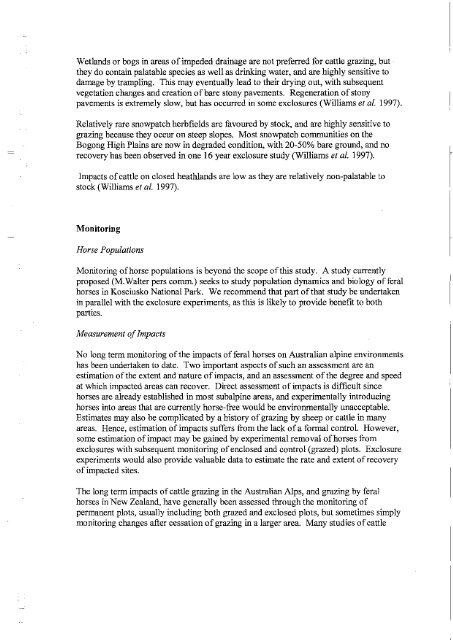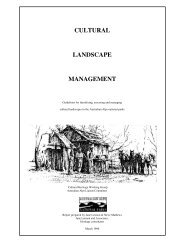Assessment of Impacts of Feral Horses - Australian Alps National ...
Assessment of Impacts of Feral Horses - Australian Alps National ...
Assessment of Impacts of Feral Horses - Australian Alps National ...
Create successful ePaper yourself
Turn your PDF publications into a flip-book with our unique Google optimized e-Paper software.
Wetlands or bogs in areas <strong>of</strong> impeded drainage are not preferred for cattle grazing, but<br />
they do contain palatable species as well as drinking water, and are highly sensitive to<br />
damage by trampling. This may eventually lead to their drying out, with subsequent<br />
vegetation changes and creation <strong>of</strong> bare stony pavements. Regeneration <strong>of</strong> stony<br />
pavements is extremely slow, but has occurred in some exclosures (Williams et al. 1997).<br />
Relatively rare snowpatch herbfields are favoured by stock, and are highly sensitive to<br />
grazing because they occur on steep slopes. Most snowpatch communities on the<br />
Bogong High Plains are now in degraded condition, with 20-50% bare ground, and no<br />
recovery has been observed in one 16 year exclosure study (Williams et al. 1997).<br />
<strong>Impacts</strong> <strong>of</strong> cattle on closed heathlands are low as they are relatively non-palatable to<br />
stock (Williams et al. 1997).<br />
Monitoring<br />
Horse Populations<br />
Monitoring <strong>of</strong> horse populations is beyond the scope <strong>of</strong> this study. A study currently<br />
proposed (M. Waiter pers comm.) seeks to study population dynamics and biology <strong>of</strong> feral<br />
horses in Kosciusko <strong>National</strong> Park. We recommend that part <strong>of</strong> that study be undertaken<br />
in parallel with the exclosure experiments, as this is likely to provide benefit to both<br />
parties.<br />
Measurement <strong>of</strong> <strong>Impacts</strong><br />
No long term monitoring <strong>of</strong> the impacts <strong>of</strong> feral horses on <strong>Australian</strong> alpine environments<br />
has been undertaken to date. Two important aspects <strong>of</strong> such an assessment are an<br />
estimation <strong>of</strong> the extent and nature <strong>of</strong> impacts, and an assessment <strong>of</strong> the degree and speed<br />
at which impacted areas can recover. Direct assessment <strong>of</strong> impacts is difficult since<br />
horses are already established in most subalpine areas, and experimentally introducing<br />
horses into areas that are currently horse-free would be environmentally unacceptable.<br />
Estimates may also be complicated by a history <strong>of</strong> grazing by sheep or cattle in many<br />
areas. Hence, estimation <strong>of</strong> impacts suffers from the lack <strong>of</strong> a formal control. However,<br />
some estimation <strong>of</strong> impact may be gained by experimental removal <strong>of</strong> horses from<br />
exclosures with subsequent monitoring <strong>of</strong> enclosed and control (grazed) plots. Exclosure<br />
experiments would also provide valuable data to estimate the rate and extent <strong>of</strong> recovery<br />
<strong>of</strong> impacted sites.<br />
The long term impacts <strong>of</strong> cattle grazing in the <strong>Australian</strong> <strong>Alps</strong>, and grazing by feral<br />
horses in New Zealand, have generally been assessed through the monitoring <strong>of</strong><br />
permanent plots, usually including both grazed and exclosed plots, but sometimes simply<br />
monitoring changes after cessation <strong>of</strong> grazing in a larger area. Many studies <strong>of</strong> cattle
















